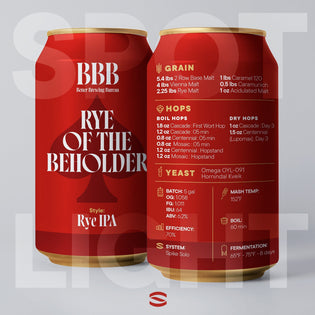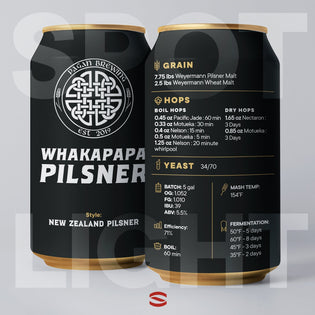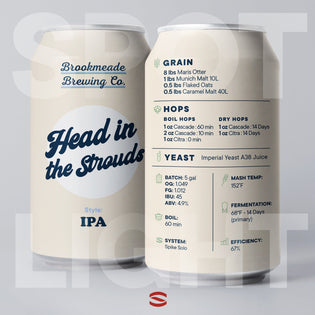
The Brewer: Greg Wegiel
With 10 years of home brewing experience under his belt, Greg Wegiel’s quest for continual improvement eventually pushed him to make the leap from a 20-gallon Spike kettle to the Spike Trio. “Going electric has given me way more control and upped the quality of my beer to the point where I was finally able to take home two ribbons at the Indiana Brewers Cup,” he says.

The Beer: German Hefeweizen
Hefeweizen is Greg’s favorite style, so it’s no surprise that he chose to create the boss of all beers. "I would say I went through about a dozen iterations of this recipe to get it right," he admits. This recipe follows a fairly traditional German Hefeweizen grain bill, with the addition of some Munich malt for flavor and color. Carapils is used at about 4-5% of the grain bill and this helps with head retention.

The Recipe: El Heffe

INGREDIENTS
GRAIN
- 5.0 lbs White Wheat Malt
- 3.3 lbs Pilsner
- 0.7 lbs Munich Malt (20L)
- 0.4 lbs Cara-Pils
HOPS
- Boil hops: 0.3 oz Hallertauer - 0:60 min
- Boil hops: 0.3 oz Hallertauer - 0:15 min
- Boil hops: 0.3 oz Perle - 0:15 min
YEAST
- Wyeast 3068
- Weihenstephan Weizen

INSTRUCTIONS
BATCH SIZE: 5 gal
OG: 1.052
FG: 1.015
IBU: 13
ABV: 5%
EFFICIENCY: 72%
MASH TEMP: 110 ºF- 20 min & 152 ºF- 60 min
BOIL: 90 min
FERMENTATION:68ºF - 2 days, 73ºF - 14 days
SYSTEM: Spike Trio

Pro Tips
- This beer uses a step mash starting at 110 degrees for a ferulic acid rest which aids in the creation of the clove flavor that is part of the Hefeweizen flavor profile. The temperature is then increased to 152 for the remainder of the mash until mashing out at 170F.
- Fermentation of this style of beer is another key aspect of the style. I pitch Wyeast 3068 at 62 degrees and hold it there for about two days. This is where the ferulic acid is turned into the clove flavor that is found in a Hefeweizen.
- I let the temperature free rise up to 73 degrees where the yeast performs its job and creates that noticeable banana flavor and aroma.
Cheers!
Greg Wegiel – Wegiel Brewing
Spike Summarizes: All Things German Hefeweizen
What is the history of German Hefeweizen?
Hefeweizen, also known as Weissbier or Weizenbier, has a long history in Germany. Originating in Bavaria, this wheat beer style has been brewed for centuries and is deeply ingrained in Bavarian beer culture.
Interestingly, Hefeweizen is one of the few exceptions to the German beer purity law, Reinheitsgebot, which traditionally allowed only barley, water, and hops in beer. This exception was made because of the high wheat content in Hefeweizen.
How does German Hefeweizen compare to other types of beer?
German Hefeweizen is quite unique, characterized by a high percentage of wheat, a distinct yeast strain, and its unfiltered nature.
It's known for a fruity (banana) and spicy (clove) character, a bright golden color with a cloudy appearance, and a fluffy, long-lasting head - all of which set it apart from many other beer styles.
What is the ideal food pairing for German Hefeweizen?
Hefeweizen is light and refreshing with a distinctive flavor profile that pairs well with a variety of dishes.
Seafood, salads, and light poultry dishes make great companions. Even brunch-style foods like eggs and sausages or sweet dishes like fruit tarts work well with Hefeweizen's fruity and spicy notes.
Is German Hefeweizen a Summer beer?
While beer enjoyment is a year-round affair, the light, refreshing nature of Hefeweizen does indeed make it a popular choice for summer imbibing.
What are the key ingredients in German Hefeweizen?
As the name suggests, wheat is a key ingredient in Hefeweizen, often comprising 50% or more of the grain bill. The other significant ingredient is the yeast, which imparts the signature banana and clove flavors.
Why is German Hefeweizen also called a "Weissbier"?
"Weissbier" means "white beer" in German, a name likely derived from the beer's pale, cloudy appearance. "Hefeweizen," on the other hand, translates to "yeast wheat," referring to the yeast left in the bottle and the high wheat content. Both terms are used interchangeably to refer to the same style.
What's the typical ABV of German Hefeweizen?
German Hefeweizens typically have a moderate alcohol content, generally around 4.5-5.5% ABV. This makes them a great choice for a sessionable drink that can be enjoyed over a period of time.
Does German Hefeweizen have a fruity flavor?
Hefeweizens are known for their characteristic banana-like fruity flavor. However, it's important to note that this isn't from added fruit, but rather a byproduct of the specific yeast strain used in fermentation.
How is German Hefeweizen beer brewed?
Brewing Hefeweizen involves a higher-than-usual proportion of wheat malt, often half or more of the total grain bill. The yeast used is a special strain that produces the signature banana and clove flavors.
Unlike many beer styles, Hefeweizen is left unfiltered, which contributes to its cloudy appearance and rich, full-bodied mouthfeel.
What's the best temperature to serve German Hefeweizen beer?
Hefeweizen is best served at a slightly cooler temperature than most ales - around 45-50°F (7-10°C). This temperature allows the distinct banana and clove flavors to shine without being overpowered by the chill.
Why is German Hefeweizen beer so carbonated?
The high carbonation level in Hefeweizen contributes to its refreshing nature and helps to enhance its unique flavor profile. It also results in the style's characteristic fluffy, long-lasting head when poured.
Are all German Hefeweizen beers the same?
While all Hefeweizens share certain characteristics – such as being brewed with a significant proportion of wheat and a specific yeast strain – there's still room for variation. Brewers can play with the malt bill, fermentation temperature, and other factors to create their own unique take on this classic style.





